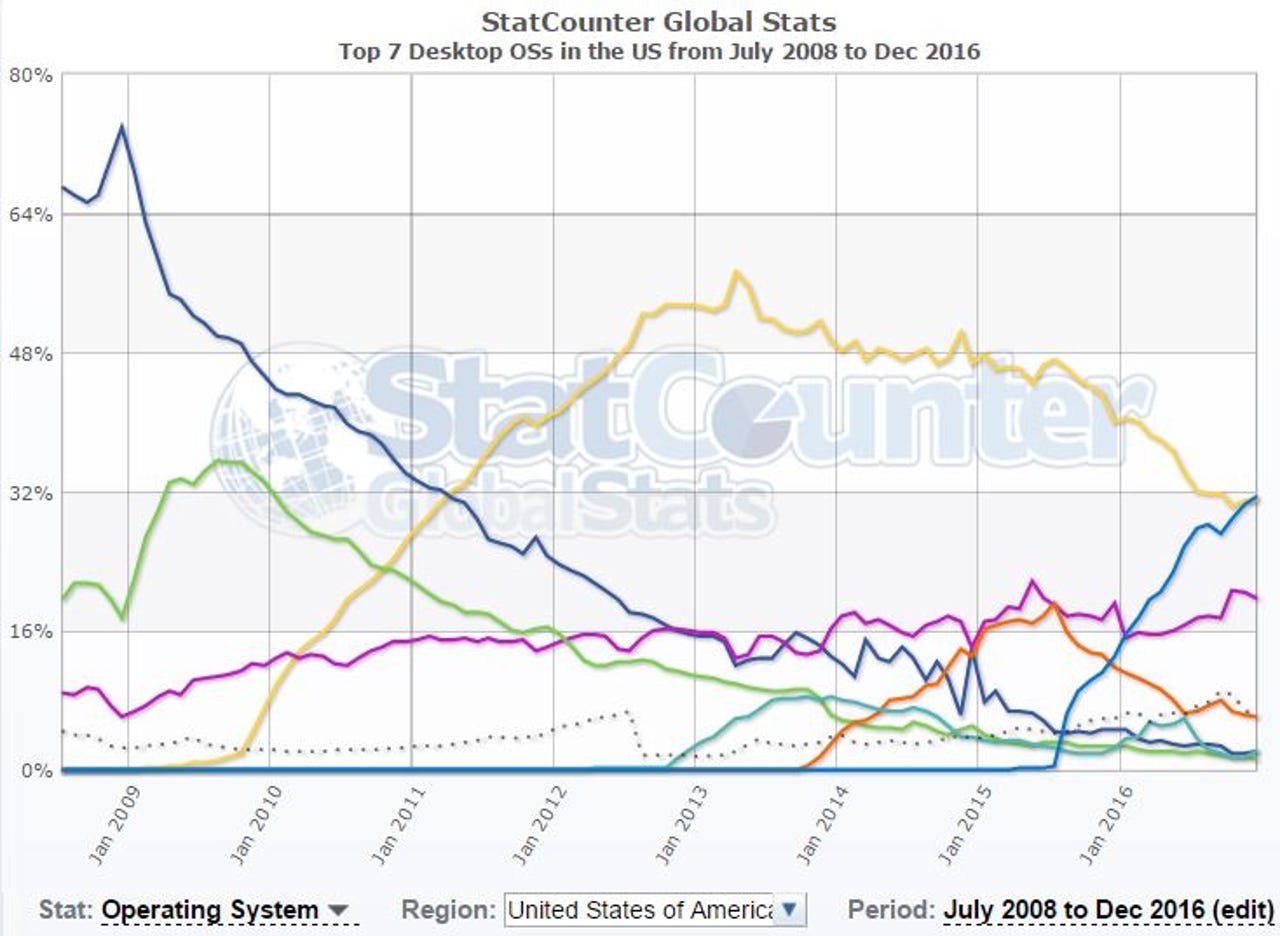Windows 10's growth has slowed, but it has overtaken Windows 7 in the UK and USA

Statcounter's graph for desktop operating system market shares in the USA shows Windows 10 climbing rapidly and only just overtaking Windows 7 (yellow line).
Installation of Microsoft's Windows 10 slowed dramatically when the free upgrade stopped, but it has still overtaken Windows 7 in the UK and USA, on Statcounter's usage-based web monitoring. On Netmarketshare's numbers, which are based on unique visitors to websites, Windows 10 finished 2016 with 24.36% of the global market, well behind Windows 7's 48.34%
Netmarketshare's numbers are balanced to include Asian markets, especially China, where Windows XP still has a significant market share, and Windows 10 adoption is correspondingly weak.
In February, I predicted that Windows 10 would get 20 of the market by the time the free upgrade stopped, and that it "could make 30 percent by Christmas, depending on whether Microsoft offers a good upgrade deal, and the general health of the PC market."
In August, I noted that Windows 10 was slightly ahead of my forecast (it reached 21.23%) but cast doubt on the Christmas figure, for two reasons. First, Microsoft did not come up with a deal to stimulate more Windows 10 installations. Second, I couldn't see much chance of a boom in PC sales before Christmas.
As things stand, Windows 10 has fallen well short, on Netmarketshare's numbers, with only 24.36% of the global market. However, at least installations seem to have started growing again, following a flat three months after the free upgrade offer ended.
From the graphs, it looks as though giving users free upgrades to Windows 10 was a winning strategy. The only mistake Microsoft made was in making it free for a year and then jumping to full price. It could have tried racking up the price to, for example, $10 in September, $20 in October, $30 in November, and so on. That way, I reckon it would have made 30% by the end of the year.
Statcounter's numbers are a bit more encouraging for Microsoft, with Windows 10's market share reaching 27.15%. It did even better in the developed world. For example, in the US market, Statcounter puts Windows 10 fractionally ahead of Windows 7, by 31.44% to 31.04%. In the UK, Statcounter puts Windows 10 well ahead of Windows 7, by 38.86% to 26.92%.
Just for the record, I don't believe either of these sets of numbers is accurate, and quoting two places of decimals is inherently silly. However, if their methodologies remain the same, they should be a reasonable guide to the changes that have taken place over 3-6 months or longer. Don't look at the numbers, look at the trends.
So what about 2017?
This year, I expect most of the growth to come from sales of new PCs, so Windows 10 is likely to have a tough time. I'll be surprised if it makes it to 40% on Netmarketshare's numbers, but 36% should be achievable.
The big question is how soon enterprises will roll out Windows 10 in volume. All the rational ones will already be running pilots, but I don't expect any significant progress much before the middle of 2018. I suspect most large companies will put it off for as long as possible, which means they'll aim to complete the upgrade by this time in 2020.
Even then, I expect there will be a rump of incompetent organisations - including many governmental organisations - that simply aren't capable of doing a simple OS upgrade to a deadline, even if they are given five years' advance warning.
We've already seen that with Windows XP. I'm pretty confident we'll see it again with Windows 7.
Netmarketshare's graph for worldwide use shows Windows 10's growth flattening after the end of Microsoft's free upgrade offer. Rapid future growth now looks unlikely.....
